Smart Techniques for Storing Shoes in a Box
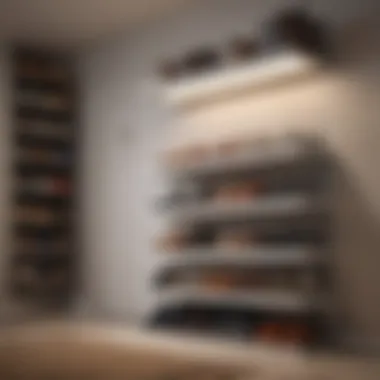
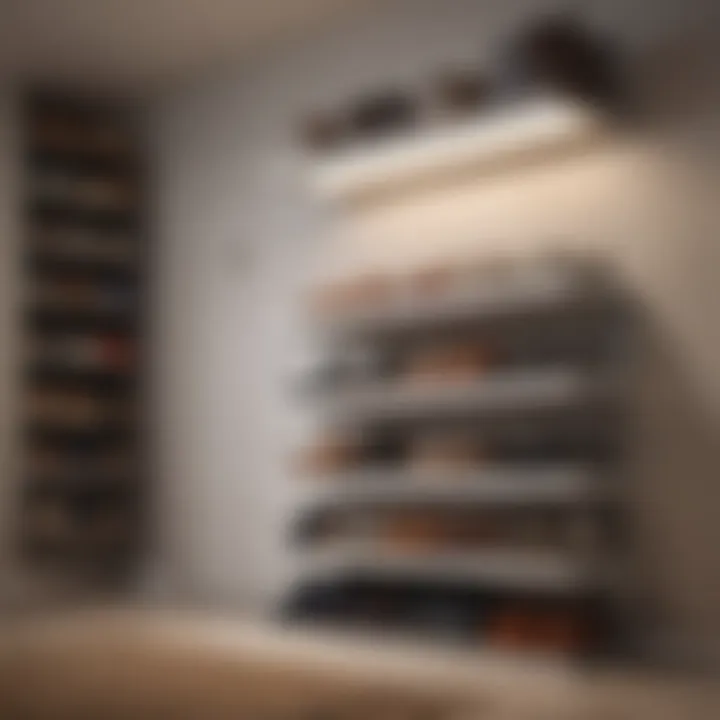
Intro
Organizing your shoes effectively can seem less significant than it truly is, but taking the time to store them properly can save you from a chaotic mess and protect your investments. Whether you're a sneakerhead with an extensive collection or someone who simply needs a way to fit their daily footwear into limited space, knowing how to store shoes in a box is vital. Not only does proper storage maintain them in pristine condition, but it also streamlines your daily routine. This means no more rummaging through piles just to find that one perfect pair.
But when it comes to choosing the right boxes, what kind do you lean towards? How do you maintain their quality? This guide will help you uncover practical strategies that suit your lifestyle and space, ensuring that your shoes remain as good as new.
In this guide, we'll delve into the nuts and bolts of effective shoe storage, discussing different box options, the importance of organization, and essential tips that span from labeling to all-around care. So, let's lace up our shoes and step into the world of thoughtful storage solutions.
Design Inspiration
Even though shoes are often tucked away in boxes, the right storage solutions can still reflect your unique style and contribute to the overall aesthetics of your space.
Current Interior Design Trends
Today, minimalism and functionality are all the rage, driven by a desire for clean lines and decluttered spaces. Opt for clear shoe boxes that showcase your collection, turning it into a stylish display rather than simply a storage solution. These clear containers not only allow you to view what's inside at a glance, but they also contribute to an airy feel, breaking away from cluttered shoe racks.
If you want to bring in creativity, consider decorative boxes that match your room's color scheme and decor. For instance, patterned boxes can become charming focal points. This will not only house your shoes but act as a part of your interior design.
"When shoes are well-stored, they remain an asset, not an eyesore."
Color Palettes and Their Effects
The colors and materials of your shoe storage can impact space perception. Lighter shades, like whites and pastels, can make a smaller area feel more open, while darker tones can lend an air of sophistication but might also create a more confined atmosphere. Mixing colors can add character, too; imagine a rustic wooden box for your casual kicks and a glossy black one for formal shoes.
Choosing colors also conveys a message about your personal style. Brighter hues could signify fun and enthusiasm, while muted tones exude calm and sophistication. In essence, when picking out boxes, think beyond mere functionality and toward how they assist in narrating your story within your living space.
Next, we will explore further practical tips and tricks that will enhance your shoe storage journey.
Understanding the Importance of Shoe Storage
When it comes to keeping our environment organized, shoe storage often gets overlooked. However, investing some time and effort into how we store our shoes can offer benefits that go beyond simple tidiness. A few well-thought-out storage practices can protect your investments and even enhance your living space, resulting in a happier home atmosphere.
Preserving Shoe Quality
Proper storage directly impacts the longevity of your shoes. Think about it: footwear takes on a lot of wear and tear from daily use. Leaving them tossed around can lead to scuffs, creases, and even a breakdown of materials over time. For instance, storing leather shoes in their original box or a dedicated shoe box helps prevent them from losing their shape and drying out. You might even consider keeping them in breathable dust bags or boxes that allow air circulation to prevent mildew.
Expensive sneakers? They deserve better than being stuffed under your bed. When stored correctly, they can retain their original look and feel for years, reminding you of the quality that you invested in.
Maximizing Space Efficiency
In an increasingly cluttered world, space is prime real estate. By adopting a systematic approach to shoe storage, you’re not only freeing up valuable floor or closet space, but you're also optimizing the area available for other essentials. For those with a large collection, using clear plastic boxes allows you to stack shoes more effectively, avoiding that chaotic heap that often arises. This way, you can utilize vertical space without creating a mess.
Additionally, grouping similar styles together or storing seasonal shoes in designated boxes can help you quickly locate what you need when you need it. Think of it as organizing your shoe library—make it functional yet stylish.
Enhancing Home Aesthetics
A well-organized shoe collection is not just about practicality; it can elevate your home’s design. Picture those chic, transparent boxes neatly lining your hallway or your closet. They offer a glimpse of your footwear collection while lending a sophisticated edge to your space. It's as though they become part of your decor instead of hidden clutter.
Incorporating creative storage methods, like decorative bins or stylish shelving systems, can add an artistic touch. This not only creates a more inviting space but also reflects your personality and sense of style. Remember, each pair of shoes tells a story—in a beautifully organized manner, they add to the overall narrative of your home.
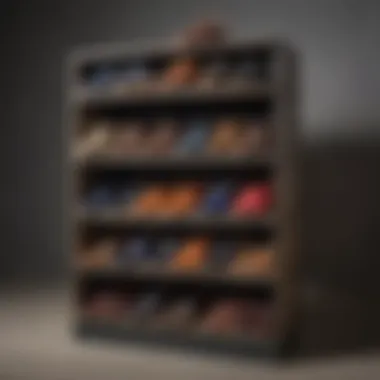
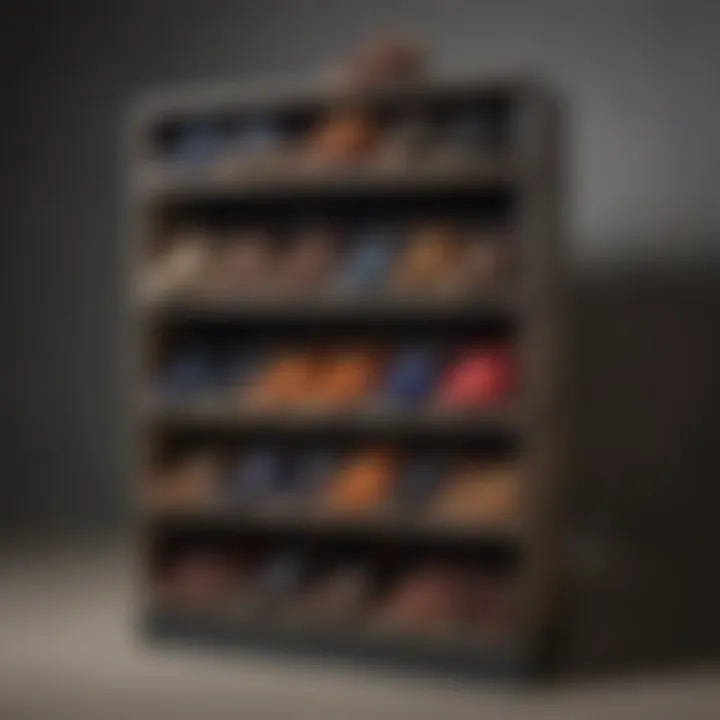
Choosing the Right Box for Your Shoes
Selecting the right box for your shoes is more than just a matter of convenience; it goes a long way in maintaining the condition of your footwear while also maximizing storage space. In households where shoe collections can number in the dozens—or even surpass the hundreds—the importance of having a well-chosen storage box becomes immediately clear. Quality boxes protect shoes from dust, moisture, and physical damage, while also making it far easier to organize and retrieve pairs when needed.
When choosing a box, several aspects come into play: materials, sizes, and ventilation. Each of these factors plays a critical role in ensuring the longevity and usability of your shoes, whether they are cherished sneakers or elegant high heels.
Materials: Cardboard vs. Plastic
When it comes to materials, the choice often boils down to cardboard or plastic. Cardboard boxes are lighter and can be more environmentally friendly. They often come with beautiful designs and can add a touch of class, especially when used for elegant shoes. However, they are unfortunately more susceptible to moisture and can deteriorate over time, especially in humid environments.
Plastic boxes, on the other hand, offer better protection from water and accidental spills. They’re also generally more durable and tend to last longer without losing their shape. However, many plastic containers are completely windowless, which may lead to a lost sight of what's inside unless you create a detailed labeling system. Ultimately, your decision depends on your shoe collection's needs and your personal preferences.
Size Considerations
Size does matter when it comes to shoe boxes. You want to ensure that your shoes fit comfortably inside without being squished. A cramped space can cause shoes to lose their shape or, worse, lead to damage. Knowing the exact dimensions of your footwear is essential. For instance, a carefully measured box can prevent excessive wear on your favorite stilettos or alternate sneakers.
Additionally, consider the stackability of the boxes. If you’re short on floor space, you might appreciate being able to stack your shoe boxes neatly on top of each other. Measuring your available storage area can also help dictate the dimensions of the boxes you purchase. Aim for a size that caters to your entire range of footwear, from flip-flops to winter boots, without excess wiggle room.
Ventilation Features
Ventilation is another crucial factor to consider when selecting shoe boxes. Shoes are prone to gather moisture, whether from simply being worn or from environmental factors. As a result, ventilated boxes can help air circulate, reducing the odds of mold or unpleasant odors developing.
Some boxes come equipped with small ventilation holes or mesh panels that allow airflow while still offering a protective space. If you frequently store shoes for extended periods, this feature could save you future headaches down the line concerning shoe integrity.
"Choosing the right storage box is not just about looks; it's about caring for your investment."
Understanding these elements will put you on the right path to making informed decisions about shoe storage. In essence, taking the time to choose suitable boxes for your footwear will help maintain their condition drastically, ensuring they stand the test of time.
Preparing Shoes for Storage
Preparing shoes for storage is a significant part of maintaining their quality and longevity. Shoes, much like various other personal belongings, can degrade if not stored correctly. The importance of this phase can not be overstated—not only does proper preparation shield shoes from wear and tear, but it also helps keep them looking their best for those occasions when you want to slip them on. When you consider that shoes often represent a financial investment, whether they be sneakers, boots, or designer heels, it becomes clear that taking the time to prep them for storage is worthwhile.
Cleaning and Drying
Before tucking your shoes away in their boxes, a thorough cleaning session is non-negotiable. Dust, dirt, or moisture left clinging to the fabric can lead to long-term damage, fostering mold or unpleasant odors. Here's a simple process to handle this:
- Check for dirt: Start by examining the shoes—look for scuff marks, mud stains, or any odd blemishes. For leather shoes, a damp cloth often does the trick, while canvas shoes may require a brush for stubborn stains.
- Gentle wash: Mix mild soap with water. Use this to gently scrub the surfaces and don't forget the insides. If your shoes are machine-washable, ensure you follow the manufacturer's instructions closely.
- Drying thoroughly: After washing, allow the shoes to air-dry completely. Avoid direct sunlight, as this can cause colors to fade. Instead, place them in a well-ventilated spot. A good tip is to stuff some newspaper inside to help absorb moisture.
By ensuring shoes are both clean and dry before storage, you save yourself the headache of odors or degradation later on.
Deodorizing Techniques
Even after cleaning, shoes can sometimes carry faint smells, which is why deodorizing is key. Here are practical and effective methods that may bring back that fresh scent:
- Baking soda: An age-old trick, placing a small open container of baking soda inside the shoe can take away odors overnight. The baking soda absorbs excess moisture and smells, working its magic without you needing to break a sweat.
- Essential oils: A drop of tea tree oil or lavender can not only mask unwanted odors but also help in sanitizing. Place a small cotton ball with the oil in each shoe, but be cautious—too much can stain materials.
- Dryer sheets: Utilizing dryer sheets is another neat trick. Placing one in each shoe can impart a pleasant aroma while keeping shoes smelling clean.
These methods can make a world of difference, particularly if you're planning on storing shoes for an extended period.
Using Shoe Trees or Stuffing
To keep the shape of your shoes intact, using shoe trees or stuffed material is a splendid idea. A shoe that loses its shape often ends up looking tired and worn, and this could happen even before it's been worn multiple times. Therefore, it’s paramount to use the right approach:
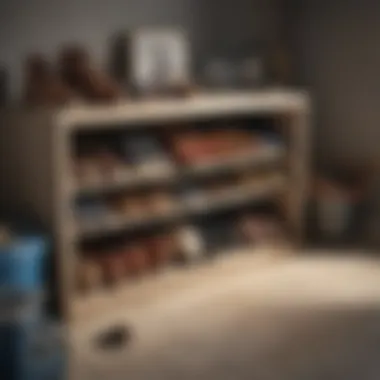
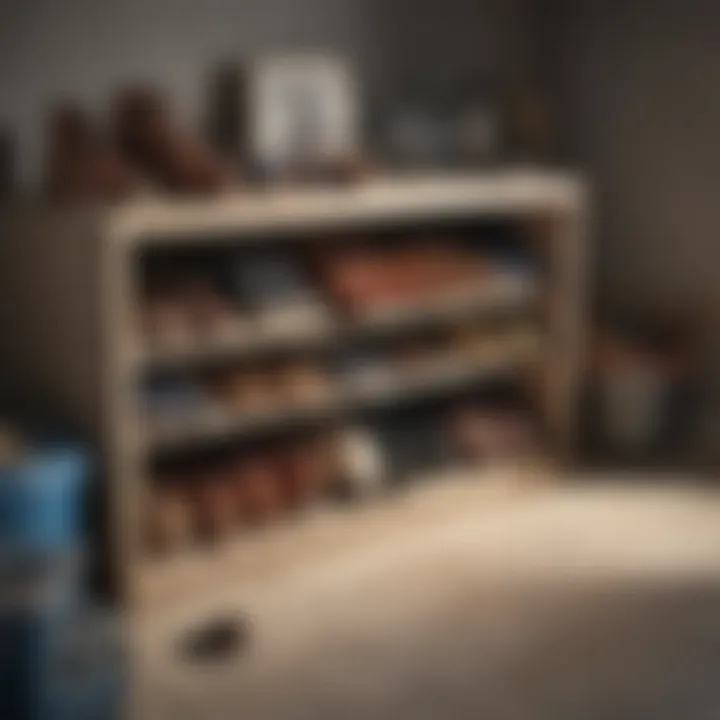
- Shoe trees: Invest in good-quality wooden shoe trees for leather shoes. They help absorb moisture and maintain shape, reducing the chances of creasing. They also promote airflow, which is beneficial for drying.
- Stuffing: For sneakers or casual shoes, crumpling up newspaper or using socks will do just fine. Make sure they're tucked in snugly to hold the shape without bulging out.
- Avoid plastic molds: While tempting, avoid plastic shoe molds for long-term storage as they can trap moisture leading to mildew.
Taking time to prep shoes before placing them in their boxes will not only ensure these products look their absolute best but also significantly extend their lifespan.
"Well-preserved shoes say more about a person than any pair can on its own."
With these strategies in mind, you can tackle the shoe storage process with confidence, knowing you're doing everything to maintain your beloved footwear.
Organizing Shoes in Boxes
When it comes to storing shoes, the way you organize them within boxes plays a pivotal role. It's more than just keeping them from getting dusty. Proper organization can prevent damage, save space, and make it far easier to locate your favorite pair without having to rummage through a sea of boxes.
Labeling Systems
A solid labeling system can mean the difference between a quick retrieval and a frustrating hunt through your collection. Use clear and concise labels that descriptive of the contents. For example, instead of a vague label like "Shoes," opt for one like "Black Heels for Work" or "Casual Sneakers for Summer." This specificity not only helps in identifying which shoes are in which box, but it also makes your storage system feel more organized.
Consider color coding or numbering systems to further simplify the process. Use a label maker for a clean look or even your handwriting for a more personal touch. The key is consistency—when boxes are labeled the same way, it reduces confusion and saves time.
Sorting by Type and Use
Sorting your shoes according to their types and intended purposes can simplify accessibility and maintain shoe quality. For instance, categorize them into dress shoes, casual footwear, athletic shoes, and seasonal variants. Each category can then be sub-sorted by color or occasion. This systematic approach not only maximizes space but also lends itself to an orderly aesthetic.
Imagine it’s an unexpected downpour and you need to grab your waterproof boots. If they’re huddled beneath your high heels without a clear sorting system, you might just call it a day and get wet. Keeping like with like lets you choose effortlessly what’s needed without tearing into boxes that don’t serve the task at hand.
Stacking for Efficiency
When it comes to utilizing vertical space, stacking shoe boxes can be a game-changer. You want to ensure that the stacks are stable and not precariously balanced—nobody wants a shoe avalanche. To avoid this, use sturdy boxes or invest in stackable solutions designed specifically for this purpose. Remember to place your most-used shoes on top for easy access.
Here are some pointers for effective stacking:
- Light on top, heavy on the bottom: Keep this rule in mind to maintain stability.
- Secure with straps or clamps: If using transparent boxes, a strap around the stack can prevent any slip.
- Label the front of each box: Labeling on the front rather than the top of the boxes will save you the trouble of removing several boxes just to see what’s inside.
Storing shoes effectively isn't about the number of pairs you have but how well you can access and maintain them for quality and longevity.
Navigating the organization of shoes in boxes ultimately becomes a balance of practicality and personal style. A well-organized collection reflects not just attention to detail but also respect for the investment that footwear represents. When every pair has a designated space, your storage system transforms from a headache into an easily navigable haven.
Storing Shoes Under Different Conditions
Storing shoes properly involves more than just placing them inside a box and calling it a day. Different conditions can significantly affect the lifespan and appearance of your prized footwear. Whether it’s the temperature, humidity, or surrounding environment, understanding these factors is crucial for optimal shoe preservation. This section dives into how storing shoes under different conditions not only maintains their quality but can also prolong wearability, ensuring that with every step, they look as good as new.
Climate-Controlled Storage Solutions
When it comes to keeping shoes in tip-top shape, climate-controlled storage is akin to providing them with a soft, cozy bed to rest in. Extremely hot or cold temperatures can warp materials or cause fabric to fade. For instance, leather, while durable, tends to be sensitive to both moisture and parched air.
Using a climate-controlled space, such as a designated room or closet with regulated temperature and humidity levels, can prevent mold growth in damp environments and reduce cracking in dry conditions. Here are some tips for making the most of a climate-controlled storage solution:
- Choose a Stable Environment: Aim for a temperature around 60-70°F with humidity around 40-60%.
- Invest in Dehumidifiers or Air Conditioners: These devices ensure a consistent climate, especially in regions prone to humidity.
- Regular Monitoring: Utilize hygrometers and thermometers to keep a close eye on the conditions inside your storage area.
By maintaining these conditions, shoes remain untarnished and ready to grace your feet whenever called upon.
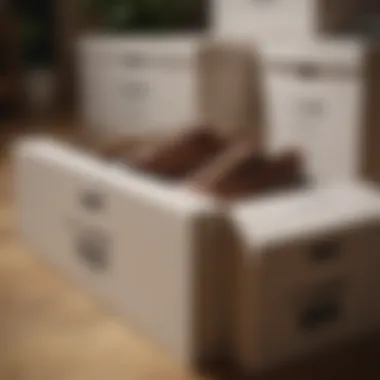

Handling Seasonal Changes
As seasons turn, so do the requirements for how shoes should be stored. The transition from summer’s heat to the brisk chill of winter brings about numerous considerations. Different materials react variably to each season, and their storage should reflect that.
During colder months, it’s common for salt and snow to wreak havoc on shoes, especially those made of suede or delicate leather. On the flip side, summer can introduce worries about sun damage and increased moisture from rain.
Here are some strategies to tackle storage as seasons change:
- Seasonal Rotation: Store off-season shoes in boxes and swap them out as required. This minimizes exposure to conditions they aren’t designed for.
- Adequate Preparation: Prior to storing away seasonal shoes, ensure they are clean, dry, and perhaps protect them with appropriate sprays or treatments specific to the material.
- Utilize Breathable Materials: When packing away shoes, opt for cotton bags or tissue paper instead of plastic. This allows the material to breathe and prevents moisture buildup.
Understanding how to adjust the storage process with the changing of the seasons can prevent long-lasting damage, ensuring you’re always ready to step out in style, no matter the weather.
The Role of Technology in Shoe Storage
In today's fast-paced world, managing one's belongings can feel like a never-ending game of Tetris. With the right approach, not only can you win that game, but you can also make sure your prized shoes glide into the right spot without a hitch. Technology plays a pivotal role here, transforming the way we store and organize our footwear. No longer are we relegated to disheveled closets or overstuffed boxes. Instead, tech offers innovative solutions that streamline the process, making it efficient and enjoyable.
Innovative Storage Solutions
When it comes to shoe storage, it’s not just about the box you use; it’s about how technology can enhance that experience. Here are some technological advancements in shoe storage:
- Smart Shoe Boxes: Some companies have developed smart shoe storage solutions that utilize sensors and LED displays. These boxes can tell you whether the shoes inside need cleaning and even suggest optimal storage conditions based on their material.
- Temperature-Controlled Keepers: Shoes made from leather or delicate materials benefit from climate control. Some storage devices can auto-regulate temperature and humidity to ensure your shoes don’t warp or deteriorate over time.
- Transparent Storage Solutions: Just as the name implies, these high-tech boxes allow you to see exactly what's inside without having to open them. They not only save time but also help maintain a visually appealing space.
"Efficient shoe storage is a balance between preservation and accessibility. With technology at our side, we can have both."
While the novelty of these innovations is alluring, it's wise to consider how they fit into your lifestyle. Not every tech solution is practical for the modest shoe collection, so weigh the benefits against your needs.
Apps for Inventory Management
Managing your shoe collection can spiral into a monumental task, especially if you’re a passionate collector or a homeowner with numerous pairs. Here’s where apps come in handy. They simplify inventory management, ensuring you know which pairs you have, where they are, and their condition.
- Inventory Tracking: Apps like ‘Sortly’ and ‘MyStuff2’ allow you to catalog your shoe collection with photos, descriptions, and categories. You can easily identify what you own; no more second-guessing about that pair buried at the back of the closet.
- Reminders and Alerts: These applications can send reminders on when to clean or check on your shoes, based on the frequency of wear or storage time. It helps ensure that no pair gets neglected.
- Sharing Capabilities: For enthusiasts who belong to shoe-sharing communities or simply like to swap, some apps allow sharing specific elements of your collection with friends. Get or give recommendations on styles and care tips!
Using these tools arms you with printed information right on your device -- a handy feature for those who like to keep their living space uncluttered, yet well-organized.
In essence, the melding of technology with shoe storage isn’t merely a trend; it’s a practical response to our evolving needs. Whether it’s through innovative storage solutions that prevent wear and tear or apps that help you keep track, expect your footwear collection to flourish under the watchful eye of technology.
Maintaining Your Shoe Collection
Maintaining your shoe collection goes beyond mere storage; it’s about cherishing each pair as an investment that deserves care and attention. Well-cared-for shoes not only elongate their lifespan but also ensure they remain in peak condition for every occasion. Whether it’s a pair of sleek loafers for a business meeting or comfortable sneakers for weekend outings, knowing how to preserve them properly is crucial. Here’s a closer look at this important aspect of shoe ownership.
Regular Inspections
To keep your shoes looking sharp and fully functional, regular inspections are a must. Checking for wear and tear—like scuff marks, loose stitching, or separated soles—can preempt bigger problems down the road. It’s wise to have a dedicated time, perhaps once a month, when you evaluate your collection.
- Look for signs of wear: Inspect the heels and soles first. If there’s noticeable thinning, it might be time for a trip to the cobbler.
- Evaluate the condition of the leather or fabric: Any creases or discolorations can often be treated with appropriate cleaners and conditioners.
- Check for odors: A quick sniff should do. If you detect any funny smells, take action fast with your favorite deodorizing methods.
Regular inspections not only keep your shoes in good shape; they also give you an insight into how frequently you use certain pairs, guiding your future purchasing decisions.
Updating Storage Techniques
As your collection evolves, it’s essential to revisit and maybe revamp your storage techniques. It’s natural for styles and needs to change over time, and your storage system should reflect that.
- Consider your current collection: Have you recently acquired several pairs? Perhaps it’s time to reorganize based on your current lifestyle.
- Explore different box options: If you started with cardboard boxes, maybe it’s worth investing in more durable plastic containers, especially for shoes with delicate materials.
- Adapting to new storage tech: Technology can play a role as well. Some apps can help you manage your shoe inventory and remind you when to rotate them for optimal wear.
"Changing how you store your shoes can breathe new life into your collection and make your selection process feel fresh and engaging."
Ultimately, maintaining your shoe collection means taking the time to care for and adapt your collection to suit your needs and the seasons. This deliberate approach will not only enhance your style but also ensure your footwear remains in excellent condition for years to come.















